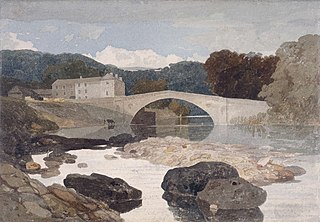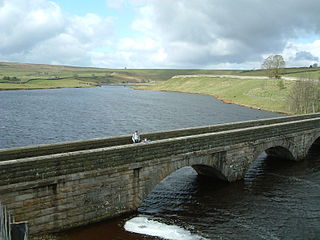
Barnard Castle is a market town on the north bank of the River Tees, in County Durham, England. The town is named after and built around a medieval castle ruin. The town's Bowes Museum has an 18th-century Silver Swan automaton exhibit and paintings by Goya and El Greco.

Low Force is an 18-foot (5.5m) high set of falls on the River Tees, England, UK. Further upstream is the High Force waterfall. Low Force is also the site of the Wynch Bridge, completed in 1830. It is suggested by signs at each end that only one person at a time should cross the bridge as it may be unstable.

The River Tees, in England, rises on the eastern slope of Cross Fell in the North Pennines and flows eastwards for 85 miles (137 km) to reach the North Sea in the North East of England. The modern-day history of the river has been tied with the industries on Teesside in its lower reaches, where it has provided the means of import and export of goods to and from the North East England. The need for water further downstream also meant that reservoirs were built in the extreme upper reaches, such as Cow Green.

Hammersmith Bridge is a suspension bridge that crosses the River Thames in west London. It links the southern part of Hammersmith in the London Borough of Hammersmith and Fulham, on the north side of the river, with Barnes in the London Borough of Richmond upon Thames, on the south side of the river. The current bridge, which is Grade II* listed and was designed by civil engineer Sir Joseph Bazalgette, is the second permanent bridge on the site, and has been attacked three times by Irish republicans.

County Durham, officially simply Durham (/ˈdʌrəm/), is a ceremonial county in North East England. The county borders Northumberland and Tyne and Wear to the north, the North Sea to the east, North Yorkshire to the south, and Cumbria to the west. The largest settlement is Darlington.

Holwick is a hamlet and civil parish in Teesdale, County Durham (district), England. Located in the Pennine hills, the hamlet consists of a few houses spread along a road in the pattern of a linear settlement. The population of the parish taken at the 2021 Census was 75.

Greta Bridge is a hamlet on the River Greta in the parishes of Rokeby and Brignall in County Durham, England. The bridge is over the River Greta, just south of its confluence with the River Tees. The North Pennines, Teesdale and the Greta Bridge area – including the Meeting of the Waters – became a source of inspiration for romantic artists, poets and writers during the eighteenth century.

Piercebridge is a village and civil parish in the borough of Darlington and the ceremonial county of Durham, England. It is situated a few miles west of the town of Darlington. It is on the site of a Roman fort of AD 260–270, which was built at the point where Dere Street crossed the River Tees. Part of the fort is under the village green. The village is sited where the York-Newstead Roman road known as Dere Street crosses the River Tees.

Winston is a village and civil parish in County Durham, England. It is situated approximately 6 miles (9.7 km) east of Barnard Castle, on a crossroads between the A67 and B6274 roads. According to the 2011 UK Census the population was 431, the parish includes the hamlets of Little Newsham and South Cleatlam.

Newbiggin is a village and civil parish in County Durham, England. At the 2011 census the parish had a population of 146. It is situated on the north side of Teesdale, opposite Holwick. An influx of Derbyshire lead miners into the area in the late 18th century may have brought the name from Biggin. The village is within the North Pennines Area of Outstanding Natural Beauty (AONB).

Middleton-in-Teesdale is a market town and civil parish in County Durham, England. It is in Teesdale, on the River Tees's north banks, and surrounded by the North Pennines. The town is between Eggleston and Newbiggin, a few miles to the north-west of Barnard Castle. In 2011 it had a population of 1137.
Whorlton is a small village in County Durham, in England. It is situated near the River Tees and to the east of Barnard Castle.

The Union Chain Bridge or Union Bridge is a suspension bridge that spans the River Tweed between Horncliffe, Northumberland, England and Fishwick, Berwickshire, Scotland. It is four miles (6.4 km) upstream of Berwick-upon-Tweed. When it opened in 1820 it was the longest wrought iron suspension bridge in the world with a span of 449 feet (137 m), and the first vehicular bridge of its type in the United Kingdom. Although work started on the Menai Suspension Bridge earlier, the Union Bridge was completed first. The suspension bridge, which is a Category A listed building in Scotland, is now the oldest to be still carrying road traffic.

Lunedale is the dale, or valley, of the River Lune, on the east side of the Pennines in England, west of Middleton-in-Teesdale. Its principal settlements are Grassholme, Thringarth and Bowbank.

A chain bridge is a historic form of suspension bridge for which chains or eyebars were used instead of wire ropes to carry the bridge deck. A famous example is the Széchenyi Chain Bridge in Budapest.

The Great Flood of 1771 affected several rivers, including the Tyne, Tees, Wear and Eden and settlements across Northern England from 16 and 17 November 1771. Its cause was a sudden thaw of the ice in upper Teesdale, a cloud burst over the Pennines and a continuous period of rain.

County Durham is a unitary authority area in the ceremonial county of County Durham, England. It is governed by Durham County Council. The district has an area of 2,226 square kilometres (859 sq mi), and contains 135 civil parishes. It forms part of the larger ceremonial county of Durham, together with boroughs of Darlington, Hartlepool, and the part of Stockton-on-Tees north of the River Tees.

Yarm Bridge is a Grade II* listed masonry road bridge over the River Tees, connecting the towns of Yarm and Egglescliffe.

Forest and Frith is a civil parish in the County Durham unitary authority, in the ceremonial county of Durham, England. In the 2011 census it had a population of 163.




















